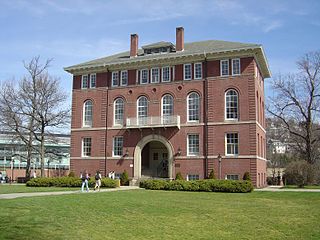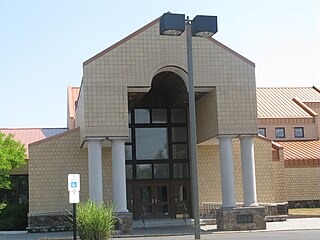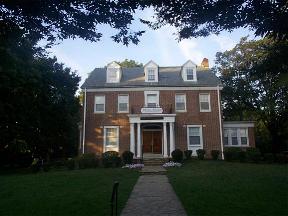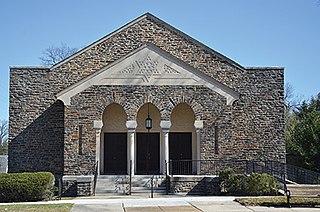
Joseph Evans Sperry (1854–1930) was an American architect, noted for designing buildings in Baltimore. He was born in Georgetown, South Carolina and later relocated to Baltimore, Maryland, where he partnered with James Bosley Noel Wyatt to form the architectural firm Wyatt and Sperry. Their affiliation lasted from 1878 to 1887. The two probably became acquainted while working in the office of Architect, E. Francis Baldwin, where he worked from 1872 until 1876. With Wyatt, he designed a number of buildings around Baltimore before breaking off on his own. Sperry became one of Baltimore's leading architects, designing many public buildings, including churches, hospitals, and banks. In 1914 he was named a Fellow of the American Institute of Architects. Sperry also designed several buildings at Johns Hopkins University and one building at West Virginia University. Sperry's most famous building is probably the Emerson "Bromo-Seltzer" Tower in Baltimore. Sperry's buildings were designed in a variety of styles, but overall were eclectic. Sperry practiced architecture independently from 1888 until he died in 1930.

Bolton Hill is a neighborhood in Baltimore, Maryland, with 20 blocks of mostly preserved buildings from the late 19th century. It is listed on the National Register of Historic Places, preserved as a Baltimore City Historic District, and included within the boundaries of Baltimore National Heritage Area. The neighborhood is bounded by North Avenue, Mount Royal Avenue, Cathedral Street, Dolphin Street, and Eutaw Place. Bolton Hill is a largely residential neighborhood with three-story row houses with red brick, white marble steps, and high ceilings. There are also larger more ornate originally single-family houses, many houses of worship, parks, monuments, and a few large apartment buildings. Many significant residents have lived in the neighborhood, including F. Scott Fitzgerald, Woodrow Wilson, the Cone sisters, and Florence Rena Sabin.

Reservoir Hill is a historic neighborhood in the city of Baltimore, Maryland, United States. It is located south of Druid Hill Park, north of Bolton Hill, east of Penn-North, and west of Jones Falls. It is bounded by Druid Park Lake Drive, the Jones Falls Expressway, North Avenue, and McCulloh Street. It is contained in the 21217 ZIP code.
William Rosenau was a leader of Reform Judaism in the beginning of the twentieth century in the United States.

Eutaw Street is a major street in Baltimore, Maryland, mostly within the downtown area. Outside of downtown, it is mostly known as Eutaw Place.

B'nai Israel Synagogue is a Modern Orthodox synagogue located in the historic Jonestown neighborhood, near downtown and the Inner Harbor of Baltimore, Maryland, in the United States. The synagogue is one of the oldest synagogue buildings in the United States.

The Lloyd Street Synagogue is a Reform and Orthodox Jewish former synagogue located on Lloyd Street, Baltimore, Maryland, in the United States. The Greek Revival-style building is the third oldest synagogue building in the United States and was the first synagogue building erected in Maryland. The building was listed on the National Register of Historic Places in 1978 and designated as a Baltimore City Landmark in 1971.

Baltimore Hebrew Congregation Synagogue is an historic former Reform Jewish synagogue building located in the Madison Park neighborhood of Baltimore, Maryland, in the United States.

Shaarei Tfiloh Synagogue, also known as the Shul in the Park, is a former Orthodox Jewish congregation and synagogue located on Druid Hill Park at 2001 Liberty Heights Avenue, Baltimore, Maryland, in the United States. Completed in 1927, in September 2023 it was reported that the synagogue had closed.

Oheb Shalom Congregation is an egalitarian, Conservative Jewish congregation and synagogue located in South Orange, Essex County, New Jersey, in the United States. The synagogue is affiliated with the United Synagogue of Conservative Judaism.
Har Sinai – Oheb Shalom Congregation is a Reform Jewish congregation and synagogue located at 7310 Park Heights Avenue, in Pikesville, Baltimore County, Maryland, in the United States. Established in 1842 in Baltimore and known as Har Sinai Congregation, and in 1853 near Camden Yards as Temple Oheb Shalom, the two congregations merged in 2019 and is the oldest Reform congregation in the United States that has used the same prayer rite since its inception.

Congregation M'kor Shalom was a Reform Jewish synagogue located at 850 Evesham Road, Cherry Hill, Camden County, New Jersey, in the United States.
The history of Czechs in Baltimore dates back to the mid-19th century. Thousands of Czechs immigrated to East Baltimore during the late 19th and early 20th centuries, becoming an important component of Baltimore's ethnic and cultural heritage. The Czech community has founded a number of cultural institutions to preserve the city's Czech heritage, including a Roman Catholic church, a heritage association, a gymnastics association, an annual festival, a language school, and a cemetery. During the height of the Czech community in the late 19th century and early 20th century, Baltimore was home to 12,000 to 15,000 people of Czech birth or heritage. The population began to decline during the mid-to-late 20th century, as the community assimilated and aged, while many Czech Americans moved to the suburbs of Baltimore. By the 1980s and early 1990s, the former Czech community in East Baltimore had been almost entirely dispersed, though a few remnants of the city's Czech cultural legacy still remain.

Few Jews arrived in Baltimore, Maryland, in its early years. As an immigrant port of entry and border town between North and South and as a manufacturing center in its own right, Baltimore has been well-positioned to reflect developments in American Jewish life. Yet, the Jewish community of Baltimore has maintained its own distinctive character as well.

Congregation Shearith Israel is a historic Orthodox Jewish congregation and synagogue, located at 5835 Park Heights Avenue, in Park Heights, northwest Baltimore, Maryland, in the United States.
Jacob Epstein was a Lithuanian-born Jewish-American merchant, philanthropist, and art collector from Baltimore, Maryland.















